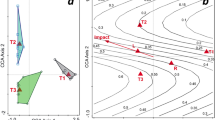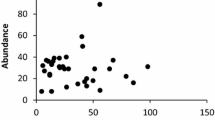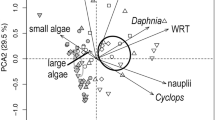Abstract
Small changes in environmental conditions can unexpectedly tip an ecosystem from one community type to another, and these often irreversible shifts have been observed in semi-arid grasslands, freshwater lakes and ponds, coral reefs, and kelp forests. A commonly accepted explanation is that these ecosystems contain multiple stable points, but experimental tests confirming multiple stable states have proven elusive. Here we present a novel approach and show that mussel beds and rockweed stands are multiple stable states on intertidal shores in the Gulf of Maine, USA. Using broad-scale observational data and long-term data from experimental clearings, we show that the removal of rockweed by winter ice scour can tip persistent rockweed stands to mussel beds. The observational data were analyzed with Anderson’s discriminant analysis of principal coordinates, which provided an objective function to separate mussel beds from rockweed stands. The function was then applied to 55 experimental plots, which had been established in rockweed stands in 1996. Based on 2005 data, all uncleared controls and all but one of the small clearings were classified as rockweed stands; 37% of the large clearings were classified as mussel beds. Our results address the establishment of mussels versus rockweeds and complement rather than refute the current paradigm that mussel beds and rockweed stands, once established, are maintained by site-specific differences in strong consumer control.



Similar content being viewed by others
References
Åberg P (1992) A demographic study of 2 populations of the seaweed Ascophyllum nodosum. Ecology 73:1473–1487
Anderson MJ, Robinson J (2003) Generalized discriminant analysis based on distances. Aust N Z J Stat 45:301–318
Anderson MJ, Willis TJ (2003) Canonical analysis of principal coordinates: a useful method of constrained ordination for ecology. Ecology 84:511–525
Bellwood DR, Hughes TP, Folke C, Nyström M (2004) Confronting the coral reef crisis. Nature 429:827–833
Bender EA, Case TJ, Gilpin ME (1984) Perturbation experiments in community ecology—theory and practice. Ecology 65:1–13
Bertness MD, Trussell GC, Ewanchuk PJ, Silliman BR (2002) Do alternate stable community states exist in the Gulf of Maine rocky intertidal zone? Ecology 83:3434–3448
Bertness MD, Trussell GC, Ewanchuk PJ, Silliman BR (2004a) Do alternate stable community states exist in the Gulf of Maine rocky intertidal zone? Reply. Ecology 85:1165–1167
Bertness MD, Trussell GC, Ewanchuk PJ, Silliman BR, Crain CM (2004b) Consumer-controlled community states on Gulf of Maine rocky shores. Ecology 85:1321–1331
Carlton JT (1982) The historical biogeography of Littorina littorea on the Atlantic coast of North America, and implications for the interpretation of the structure of New England intertidal communities. Malacol Rev 15:146
Carpenter SR, Ludwig D, Brock WA (1999) Management of eutrophication for lakes subject to potentially irreversible change. Ecol Appl 9:751–771
Chapman ARO (1995) Functional ecology of fucoid algae—23 years of progress. Phycologia 34:1–32
Chase JM (2003) Experimental evidence for alternative stable equilibria in a benthic pond food web. Ecol Lett 6:733–741
Chipperfield PNJ (1953) Observations on the breeding and recruitment of Mytilus edulis (L.) in British waters. J Marine Biol Assoc U K 32:449–476
Connell JH, Slatyer RO (1977) Mechanisms of succession in natural communities and their role in community stability and organization. Am Nat 111:1119–1144
Connell JH, Sousa WP (1983) On the evidence needed to judge ecological stability or persistence. Am Nat 121:789–824
Dudgeon S, Petraitis PS (2001) Scale-dependent recruitment and divergence of intertidal communities. Ecology 82:991–1006
Dudgeon S, Petraitis PS (2005) First year demography of the foundation species, Ascophyllum nodosum, and its community implications. Oikos 109:405–415
Dudgeon S, Kübler JE, Wright WA, Vadas RL, Petraitis PS (2001) Natural variability in zygote dispersal of Ascophyllum nodosum at small spatial scales. Funct Ecol 15:595–604
Estes JA, Tinker MT, Williams TM, Doak DF (1998) Killer whale predation on sea otters linking oceanic and nearshore ecosystems. Science 282:473–476
Fairweather PG, Underwood AJ (1983) The apparent diet of predators and biases due to different handling times of their prey. Oecologia 56:169–179
Grimm V, Wissel C (1997) Babel, or the ecological stability discussions: an inventory and analysis of terminology and a guide for avoiding confusion. Oecologia 109:323–334
Hughes TP (1994) Catastrophes, phase-shifts, and large-scale degradation of a Caribbean coral-reef. Science 265:1547–1551
Leonard GH, Levine JM, Schmidt PR, Bertness MD (1998) Flow-driven variation in intertidal community structure in a Maine estuary. Ecology 79:1395–1411
Lewontin RC (1969) The meaning of stability. In: Woodwell GM, Smith HH (eds) Diversity and stability in ecological systems, vol 22. Brookhaven National Laboratory, Upton, pp 13–24
Lubchenco J (1983) Littorina and Fucus—effects of herbivores, substratum heterogeneity, and plant escapes during succession. Ecology 64:1116–1123
Lubchenco J, Menge BA (1978) Community development and persistence in a low rocky inter-tidal zone. Ecol Monogr 48:67–94
May RM (1977) Thresholds and breakpoints in ecosystems with a multiplicity of stable states. Nature 269:471–477
Menge BA (1976) Organization of New England rocky intertidal community—role of predation, competition, and environmental heterogeneity. Ecol Monogr 46:355–393
Paine RT, Trimble AC (2004) Abrupt community change on a rocky shore—biological mechanisms contributing to the potential formation of an alternative state. Ecol Lett 7:441–445
Paine RT, Castilla JC, Cancino J (1985) Perturbation and recovery patterns of starfish-dominated intertidal assemblages in Chile, New Zealand, and Washington State. Am Nat 125:679–691
Peterson CH (1984) Does a rigorous criterion for environmental identity preclude the existence of multiple stable points? Am Nat 124:127–133
Peterson CH, Bradley BP (1978) Estimating diet of a sluggish predator from field observations. J Fish Res Board Can 35:136–141
Petraitis PS (1987) Immobilization of the predatory gastropod, Nucella lapillus, by its prey, Mytilus edulis. Biol Bull 172:307–314
Petraitis PS (1990) Direct and indirect effects of predation, herbivory and surface rugosity on mussel recruitment. Oecologia 83:405–413
Petraitis PS, Dudgeon SR (1999) Experimental evidence for the origin of alternative communities on rocky intertidal shores. Oikos 84:239–245
Petraitis PS, Dudgeon SR (2004a) Detection of alternative stable states in marine communities. J Exp Marine Biol Ecol 300:343–371
Petraitis PS, Dudgeon SR (2004b) Do alternate stable community states exist in the Gulf of Maine rocky intertidal zone? Comment. Ecology 85:1160–1165
Petraitis PS, Dudgeon SR (2005) Divergent succession and implications for alternative states on rocky intertidal shores. J Exp Marine Biol Ecol 326:14–26
Petraitis PS, Latham RE (1999) The importance of scale in testing the origins of alternative community states. Ecology 80:429–442
Petraitis PS, Methratta ET (2006) Using patterns of variability to test for multiple community states on rocky intertidal shores. J Exp Marine Biol Ecol 338:222–232
Petraitis PS, Vidargas N (2006) Marine intertidal organisms found in experimental clearings on sheltered shores in the Gulf of Maine, USA (Ecol Arch E087-047). Ecology 87:795
Petraitis PS, Rhile EC, Dudgeon S (2003) Survivorship of juvenile barnacles and mussels: spatial dependence and the origin of alternative communities. J Exp Marine Biol Ecol 293:217–236
Petraitis PS, Liu H, Rhile EC (2008) Densities and cover data for intertidal organisms in the Gulf of Maine, USA, from 2003 to 2007 (Ecol Arch E089-032). Ecology 89:588
Scheffer M, Carpenter SR (2003) Catastrophic regime shifts in ecosystems: linking theory to observation. Trends Ecol Evol 18:648–656
Scheffer M, Hosper SH, Meijer ML, Moss B, Jeppesen E (1993) Alternative equilibria in shallow lakes. Trends Ecol Evol 8:275–279
Scheffer M, Carpenter S, Foley JA, Folke C, Walker B (2001) Catastrophic shifts in ecosystems. Nature 413:591–596
Schröder A, Persson L, De Roos AM (2005) Direct experimental evidence for alternative stable states: a review. Oikos 110:3–19
Seed R (1969) The ecology of Mytilus edulis L. (Lamellibranchiata) on exposed shores. I. Breeding and settlement. Oecologia 3:277–316
Shurin JB, Amarasekare P, Chase JM, Holt RD, Hoopes MF, Leibold MA (2004) Alternative stable states and regional community structure. J Theor Biol 227:359–368
Simenstad CA, Estes JA, Kenyon KW (1978) Aleuts, sea otters, and alternate stable state communities. Science 200:403–411
Sousa WP, Connell JH (1985) Further comments on the evidence for multiple stable points in natural communities. Am Nat 125:612–615
Suding KN, Gross KL, Houseman GR (2004) Alternative states and positive feedbacks in restoration ecology. Trends Ecol Evol 19:46–53
Sutherland JP (1981) The fouling community at Beaufort, North Carolina—a study in stability. Am Nat 118:499–519
Sutherland JP (1990) Perturbations, resistance, and alternative views of the existence of multiple stable points in nature. Am Nat 136:270–275
van de Koppel J, Rietkerk M, Weissing FJ (1997) Catastrophic vegetation shifts and soil degradation in terrestrial grazing systems. Trends Ecol Evol 12:352–356
Acknowledgements
We thank M. J. Anderson who provided the CAP and PREDICTION programs as freeware, and B. Boldgiv, J. C. Castilla, and J. A. D. Fisher who read and commented on earlier drafts of the manuscript. We are also grateful for the support of this research by the residents of Swan’s Island who provided access to the shore across their properties. Research was supported by National Science Foundation awards to P. S. Petraitis (OCE 95-29564 and DEB LTREB 03-14980) and by a RET award to E. C. Rhile (Research Experiences for Teachers supplemental to DEB LTREB 03-14980). S. R. Dudgeon was supported by the National Institutes of Health GMS-MBRS-SCORE program (NIH-5SO6GM48680) during the writing of the manuscript. Earlier drafts were written while Petraitis was a Fulbright Scholar in Chile, and he is deeply grateful to the Comisión Fulbright Chile, the Departamento de Ecología, Pontificia Universidad Católica de Chile, and J. C. Castilla for their support and hospitality.
Author information
Authors and Affiliations
Corresponding author
Additional information
Communicated by Pete Peterson.
Electronic supplementary material
Below is the link to the electronic supplementary material.
Rights and permissions
About this article
Cite this article
Petraitis, P.S., Methratta, E.T., Rhile, E.C. et al. Experimental confirmation of multiple community states in a marine ecosystem. Oecologia 161, 139–148 (2009). https://doi.org/10.1007/s00442-009-1350-9
Received:
Accepted:
Published:
Issue Date:
DOI: https://doi.org/10.1007/s00442-009-1350-9




